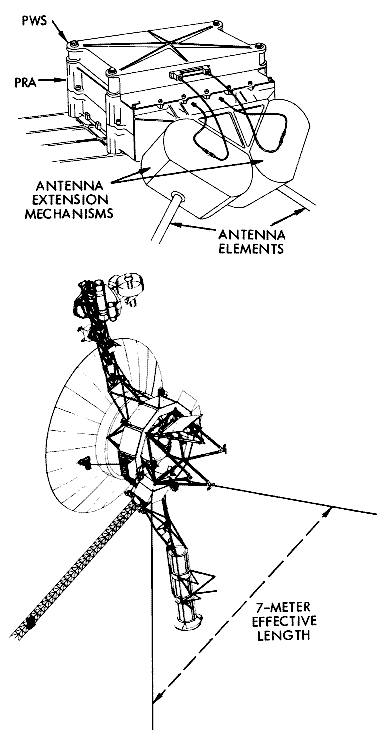Plasma Wave Subsystem on:
[Wikipedia]
[Google]
[Amazon]
 Plasma Wave Subsystem (sometimes called Plasma Wave System), abbreviated PWS, is an instrument that is on board the ''
Plasma Wave Subsystem (sometimes called Plasma Wave System), abbreviated PWS, is an instrument that is on board the ''

PWS
{{Voyager program Voyager program Spacecraft instruments
 Plasma Wave Subsystem (sometimes called Plasma Wave System), abbreviated PWS, is an instrument that is on board the ''
Plasma Wave Subsystem (sometimes called Plasma Wave System), abbreviated PWS, is an instrument that is on board the ''Voyager 1
''Voyager 1'' is a space probe launched by NASA on September 5, 1977, as part of the Voyager program to study the outer Solar System and the interstellar medium, interstellar space beyond the Sun's heliosphere. It was launched 16 days afte ...
'' and ''Voyager 2
''Voyager 2'' is a space probe launched by NASA on August 20, 1977, as a part of the Voyager program. It was launched on a trajectory towards the gas giants (Jupiter and Saturn) and enabled further encounters with the ice giants (Uranus and ...
'' unmanned probes of the Voyager program
The Voyager program is an American scientific program that employs two interstellar probes, ''Voyager 1'' and ''Voyager 2''. They were launched in 1977 to take advantage of a favorable planetary alignment to explore the two gas giants Jupiter ...
. The device is 16 channel step frequency receiver and a low-frequency waveform receiver that can measure electron
The electron (, or in nuclear reactions) is a subatomic particle with a negative one elementary charge, elementary electric charge. It is a fundamental particle that comprises the ordinary matter that makes up the universe, along with up qua ...
density. The PWS uses the two long antenna in a V-shape on the spacecraft, which are also used by another instrument on the spacecraft. The instrument recorded data about the Solar System's gas giants, and about the outer reaches of the Heliosphere
The heliosphere is the magnetosphere, astrosphere, and outermost atmospheric layer of the Sun. It takes the shape of a vast, tailed bubble-like region of space. In plasma physics terms, it is the cavity formed by the Sun in the surrounding ...
, and beyond. In the 2010s, the PWS was used to play the "sounds of interstellar space" as the spacecraft can sample the local interstellar medium
The interstellar medium (ISM) is the matter and radiation that exists in the outer space, space between the star systems in a galaxy. This matter includes gas in ionic, atomic, and molecular form, as well as cosmic dust, dust and cosmic rays. It f ...
after they departed the Sun's heliosphere. The heliosphere is a region essentially under the influence of the Sun's solar wind, rather than the local interstellar environment, and is another way of understanding the Solar System in comparison to the objects gravitationally bound
The gravitational binding energy of a system is the minimum energy which must be added to it in order for the system to cease being in a gravitationally bound state. A gravitationally bound system has a lower (''i.e.'', more negative) gravitatio ...
(e.g in orbit) around Earth's Sun.
The PWS instrument plan was introduced in 1974 during the development of the Voyager program. It was hoped it would help increase understanding of wave particle interactions and record data on the magnetosphere
In astronomy and planetary science, a magnetosphere is a region of space surrounding an astronomical object in which charged particles are affected by that object's magnetic field. It is created by a celestial body with an active interior Dynamo ...
s of planets like Jupiter and Saturn. The instruments went on to record radio waves at Jupiter, Saturn, Uranus, and Neptune.
The PWS instrument is one of the instruments that is a part of the Voyager interstellar mission, and they have operated for several decades after their 1977 launch into the 2010s.
Frederick L. Scarf of TRW was the first PI. After Scarf's death in 1988, Donald Gurnett became the PI.
Specifications
List: *Mass: 1.4 kg (3.08 pounds) *Average electrical power consumption: 1.3watt
The watt (symbol: W) is the unit of Power (physics), power or radiant flux in the International System of Units (SI), equal to 1 joule per second or 1 kg⋅m2⋅s−3. It is used to quantification (science), quantify the rate of Work ...
s
*Average data rate: 0.032 kbit/s
In telecommunications, data transfer rate is the average number of bits ( bitrate), characters or symbols ( baudrate), or data blocks per unit time passing through a communication link in a data-transmission system. Common data rate units are mu ...
*Frequency range 10 Hz to 56 kHz
*PWS/PRA Antenna:
**Length of antenna: 10 meters (10.936 yards)
**Number of antenna: 2
**Angle between antenna: 90 degrees
PWS and PRS

See also
*''New Horizons
''New Horizons'' is an Interplanetary spaceflight, interplanetary space probe launched as a part of NASA's New Frontiers program. Engineered by the Johns Hopkins University Applied Physics Laboratory (APL) and the Southwest Research Institut ...
'' (see plasma and high-energy particle spectrometer suite)
*Waves in plasmas
In plasma physics, waves in plasmas are an interconnected set of particles and fields which propagate in a periodically repeating fashion. A plasma is a quasineutral, electrically conductive fluid. In the simplest case, it is composed of electro ...
* Waves (''Juno'') (Spacecraft instrument aboard the ''Juno'' Jupiter orbiter of the 2010s)
References
External links
PWS
{{Voyager program Voyager program Spacecraft instruments